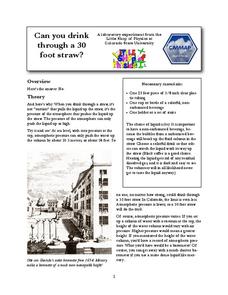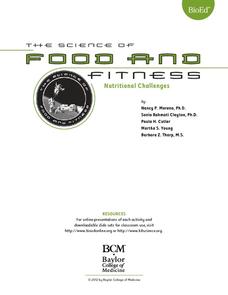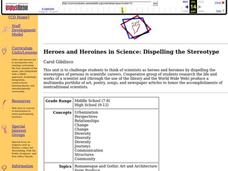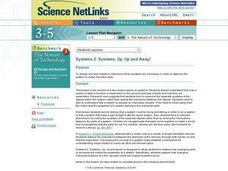Urbana School District
Thermodynamics
Entropy, it isn't what it used to be. Presentation includes kinetic-molecular theory, heat and internal energy, thermal equilibrium, temperature scales, laws of thermodynamics, entropy, latent heat of fusion, specific heat, calorimetry,...
Colorado State University
Can You Drink Through a 30 Foot Straw?
Drinking straws are a pretty simple device ... or, are they? Explore the possibility of sipping a beverage 30 feet away with an engaging activity that's sure to keep pupils guessing. Just place a long piece of plastic tubing in a glass,...
Colorado State University
Why Do Hurricanes Go Counterclockwise in the Northern Hemisphere?
Test your class' coordination as they model the Coriolis Effect. Forming a large circle, learners move to the right as they try to toss a ball to the person across from them. The movement of the circle represents the rotation of the...
NOAA
I Didn’t Do It…Did I?: Make Your Own Greenhouse Effect
How do greenhouse gases affect the climate on Earth? Pupils explore the concept by first building their own apparatuses to model the greenhouse effect. Then, they record data to measure temperature change and determine...
BioEd Online
Nutritional Challenges
Eating healthy can be a challenge, especially for people with special dietary needs. After learning about standard nutritional needs for adults, learners take on the role of a dietician and work together to create a menu for one of the...
Polar Trec
Arctic Smorgasbord!
Two blooms of phytoplankton, instead of just one, now occur in the Arctic due to declining sea ice, which will have widespread effects on the marine life and climate. In small groups, participants build an Arctic food web with given...
Polar Trec
Permafrost Thaw Depth and Ground Cover
The thaw depth of tundra creates a positive feedback loop with both global warming and the carbon cycle. Scholars sort photos and develop a hypothesis for ground cover and permafrost depth. Then they review the data and measurements...
Biology Junction
Cellular Division
Based on current scientific knowledge, all cells come from preexisting cells. Scholars learn about cell division, cell replication, mitosis, meiosis, and more with a PowerPoint. It describes the differences between prokaryotes and...
American Museum of Natural History
Around the World with DNA
DNA analysis could be what saves some animals from extinction. An interactive lesson shows learners how DNA information proves variation among animals of the same species and how stakeholders use that information to make decisions. Easy...
CK-12 Foundation
Oscillations Simulation
What makes a swing go back and forth like a pendulum rather than going all the way around? Scholars use the simulation to explore pendulums and how they work. They vary the weight, length of the rope, and even gravity in various trials.
Howard Hughes Medical Institute
Lesson 5: Tracking Lion Communities
Researchers in Gorongosa National Park placed cameras there many years ago to understand what was happening with the lion communities that lived there. Little did they know, they opened a door to so much more! Inquisitive...
Curated OER
What Configurations Work to Light a Bulb?
Students explore simple electrical circuits. Students experiment, using different configurations, to determine what is necessary to compeete a circuit. Students observe similarities between arrangements that work and differences in...
Curated OER
Heroes and Heroines in Science: Dispelling the Stereotype
Students describe and illustrate a stereotypical scientist. They work in cooperative groups to research and produce a portfolio of work honoring a randomly chosen nontraditional scientist. Students create a presentation about their...
Curated OER
Heroes and Heroines in Science: Dispelling the Stereotype
students think of scientists as heroes and heroines by dispelling the stereotypes of persons in scientific careers. They work in cooperative groups to research the life and works of a scientist and (through the use of the library and the...
Curated OER
What is a Watershed, Anyway?
Learners constrct a watershed and write about their observations. Students use maps to locate their area in relation to the watershed and inquire about what is applied to the ground above.
Curated OER
What Is A Dinosaur?
Pupils use the question of "What is a dinosaur?" in order to establish the context for a class investigation. They use a variety of resources in order to gather information. Students compare and contrast the similarities or differences...
Curated OER
Magnificent Microscopes Unit Including Mystery and Alternative Assessment Activity
After drawing and labelling a microscope, forensic science explorers use one to solve a simulated murder mystery. They examine each piece of evidence and draw what they observe at each magnification. Working in groups of four, your...
Curated OER
River of Venom
Read an exciting science mystery about killer bees online, evaluate a list of clues, and try to answer the questions correctly. The story responds to the reader's choices and presents research material for the next step. Though the...
Curated OER
Systems, UP, Up and Away!
Students discuss rockets and how they work. Students research basic information about the Space Shuttle. Students work in collaborative groups creating "rockets" with empty film canisters. Students launch their "rockets" and record...
Curated OER
The Sky Show
Learners use the internet to gather information to create their own science lesson plan. They choose from optical, wind, or electrical phenomena and use the internet to research information. Finally, they organize the information they...
Curated OER
Earthquake Plan
Young scholars discuss what to do in the event of an earthquake. They develop an earthquake plan and practice it. They also discuss their fears about earthquakes.
Curated OER
Food Packaging
Students identify the functions of packaging food and how the designs work. In this food packaging lesson students identify the changes that occur in different types of materials.
Curated OER
Air Pollution and Asthma (11th Grade)
What is the air quality index? Start by discussing pollution and air quality with your budding environmentalists. A list of instructional activities are provided here from inviting a guest speaker into your classroom to discussing...
National Center for Case Study Teaching in Science
A Rose By Any Other Name
In part one, your astronomers read an interview dialogue between a reporter and Dr. Maria Ocasio, the chair of the group that assigns names to celestial objects. The topic in question is Pluto's status. Learners research Plutinos and...























